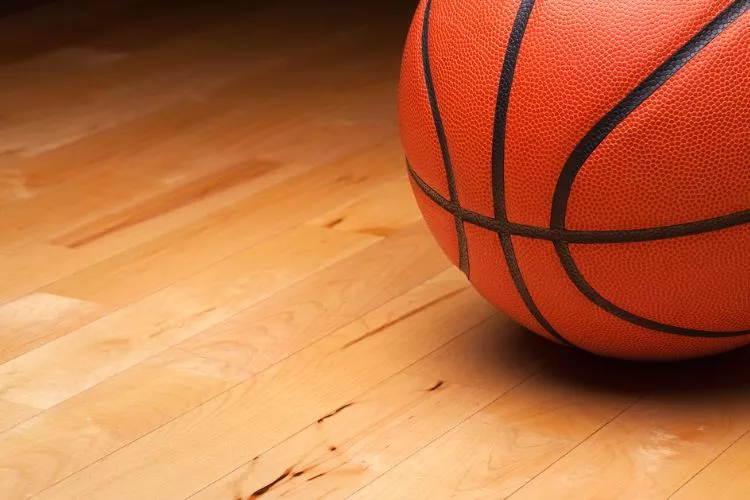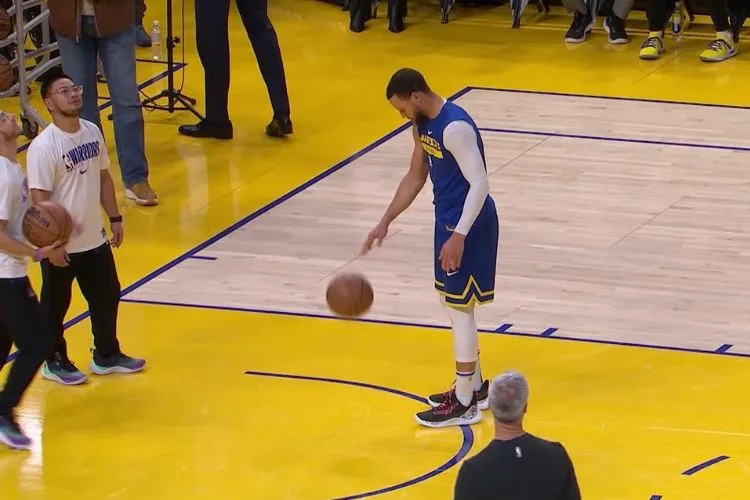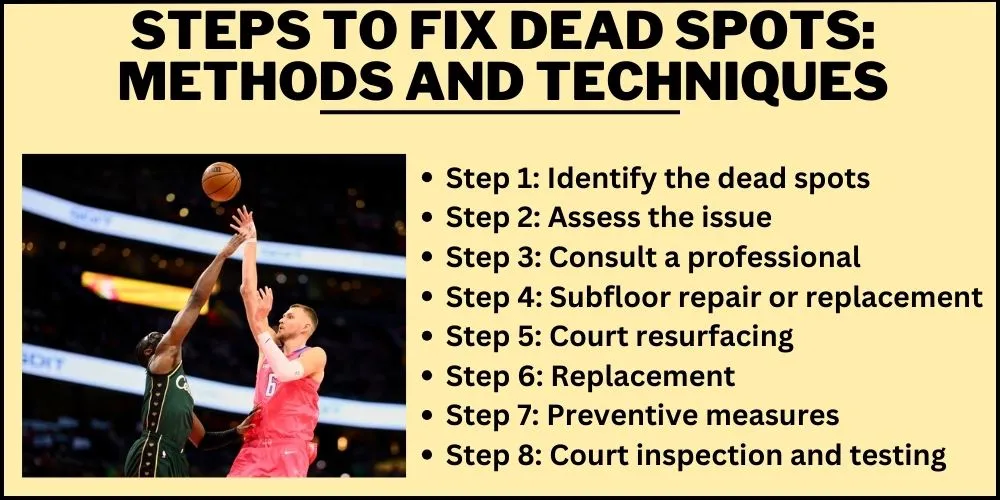Unseen to the untrained eye, hiding subtly yet crucially in plain sight, lies an enigmatic feature of the basketball court called the ‘Dead Spot’.
But, exactly what is a dead spot on a basketball court? Do you know that?
Well, a dead spot on a basketball court is not an obvious element like the hoop, the backboard, or the three-point line, yet it can profoundly influence the game.

This article aims to uncover these mysterious areas, their mechanisms, and their impact on the game that enthusiasts, athletes, and spectators love so much. Let’s decode the enigma behind the dead spot on a basketball court.
What is a dead spot on a basketball court?
A ‘Dead Spot’ on a basketball court refers to a specific area where the playing surface doesn’t have the same level of spring or bounce as the rest.
When the ball hits this spot, it doesn’t rebound with the usual responsiveness, causing it to behave unpredictably and potentially disrupting the game’s flow.
Dead spots are undesirable due to poor construction, uneven surfaces, lack of proper maintenance, or underlying structural issues. They represent an irregularity in the uniformity of the surface and can pose challenges to players who expect a consistent bounce across the entire court.
Dead spots can interrupt gameplay and lead to potential injuries, emphasizing the need for regular inspections and maintenance of the court surface.
What causes dead spots on basketball courts?
Dead spots on a basketball court are predominantly caused by court construction and maintenance issues. Here are some key factors:
- Poor Installation or Construction: If a court isn’t properly installed, it may lead to uneven surfaces, creating potential dead spots.
- Subfloor Issues: If the subfloor beneath the surface isn’t consistent, it can lead to variations in the playing surface’s responsiveness, causing dead spots.
- Lack of Maintenance: General wear and tear over time can decrease a court’s uniformity. Regular maintenance and inspections are essential for maintaining a consistent playing surface.
- Underlying Water Damage: Often, water can seep into wooden courts, causing damage and warping that result in dead spots.
- Improper Material: Using inappropriate or low-quality materials for the court surface can lead to inconsistent bounce characteristics.
By avoiding these issues during construction and ongoing maintenance, courts can help mitigate the likelihood of dead spots.
The Impact of Dead Spots on Gameplay
Dead spots on a basketball court can significantly impact gameplay. They add an unpredictable element to the game, changing the ball’s bounce pattern and possibly disrupting planned play strategies.
When a player dribbles or passes the ball and hits a dead spot, it may not bounce back as expected. This can result in lost control of the ball, potentially turning over possession to the opposing team, missing shot opportunities, or messing up a carefully planned attack strategy.

Similarly, the inconsistency in bounce may throw off a player’s shooting rhythm, particularly during free throws or three-point attempts where a bounce off the backboard is factored in. Dead spots can potentially change a basketball game’s tempo and outcome.
Furthermore, dead spots can pose safety risks. Players making high-speed movements could unexpectedly lose balance or misstep because the ball reacts differently, leading to potential injuries. This emphasizes why it is paramount that dead spots should be promptly identified and addressed.
Recognizing and Identifying Dead Spots
Identifying dead spots on a basketball court requires a vigilant and systematic approach. Often, these spots aren’t visible, making it challenging.
Players, coaches, or maintenance staff regularly involved in court activities may notice inconsistencies in the ball’s bounce pattern suggestive of a potential dead spot. These areas could be marked for further testing.
There are specific procedures and tools designed to detect dead spots. For example, an industry-standard method involves bouncing a basketball at a consistent force across various court parts and observing where the bounce height significantly decreases.
Certain innovative technologies, such as surface evenness testers and sophisticated sound-based or imaging techniques, can also identify inconsistencies in the court surface.
Once the potential dead spots are identified, professional technicians should verify them before proceeding with the appropriate repairs.
Regular court inspections and maintenance can help quickly notice any developing inconsistencies and prevent them from impacting the gameplay or player safety.
Steps to Fix Dead Spots: Methods and Techniques
Fixing dead spots on a basketball court requires careful evaluation and professional intervention. While minor repair work might be done by maintenance staff, it is recommended to involve sports flooring specialists for large-scale or complicated issues. Below is a step-by-step guide to fixing dead spots.

Step 1: Identify the dead spots
As mentioned, identify potential dead spots by bouncing a ball consistently across the court, using evenness testers, sound-based techniques, or imaging methods.
Step 2: Assess the issue
Once the dead spots are identified, assess the severity and cause to determine the appropriate repair method. Causes could range from subfloor inconsistencies to damaged flooring material or water damage.
Step 3: Consult a professional
If the issue’s nature and extent lie beyond routine maintenance, consult sports flooring specialists to inspect the court and recommend the best action.
Step 4: Subfloor repair or replacement
If subfloor inconsistencies are the primary cause, professionals may recommend leveling the subfloor to fix any underlying irregularities. In some cases, they may suggest replacing damaged or water-affected sections of the subfloor.
Step 5: Court resurfacing
Following subfloor repair or replacement, professionals may resurface the court by sanding and refinishing the hardwood to create a consistent playing surface. Depending on the court material, an appropriate resurfacing method will be chosen.
Step 6: Replacement
In cases where dead spots are widely spread, or the damage is severe, replacing the entire basketball court surface might be necessary. Professionals will take appropriate steps to remove the existing flooring, ensure the subfloor is level and repaired, and install a new surface.
Step 7: Preventive measures
To prevent future dead spots, take regular preventive measures, including proper maintenance, weather protection, and moisture control. Keeping the court surface clean and dry and scheduling regular inspections can help safeguard against the formation of new dead spots.
Step 8: Court inspection and testing
Finally, upon completion of the repair process, conduct a thorough inspection and testing of the court surface to confirm that the dead spots have been eliminated and the playing surface is restored to its uniform state.
Do note that these steps are a general outline and may vary according to specific court conditions and material types. Always consult professional sports flooring specialists for tailored solutions and expert advice.
Conclusion:
Dead spots on a basketball court can significantly impact the athletes’ gameplay, strategy, and overall safety.
While they remain invisible to the casual observer, understanding their nature, causes, and the methods to detect and treat them is crucial for maintaining a high-quality, fair, and safe game environment.
By investing in regular inspections, diligent maintenance, and prompt professional repairs when necessary, we can preserve the integrity and uniformity of the basketball court, thereby enhancing the overall sporting experience for both athletes and spectators alike.
